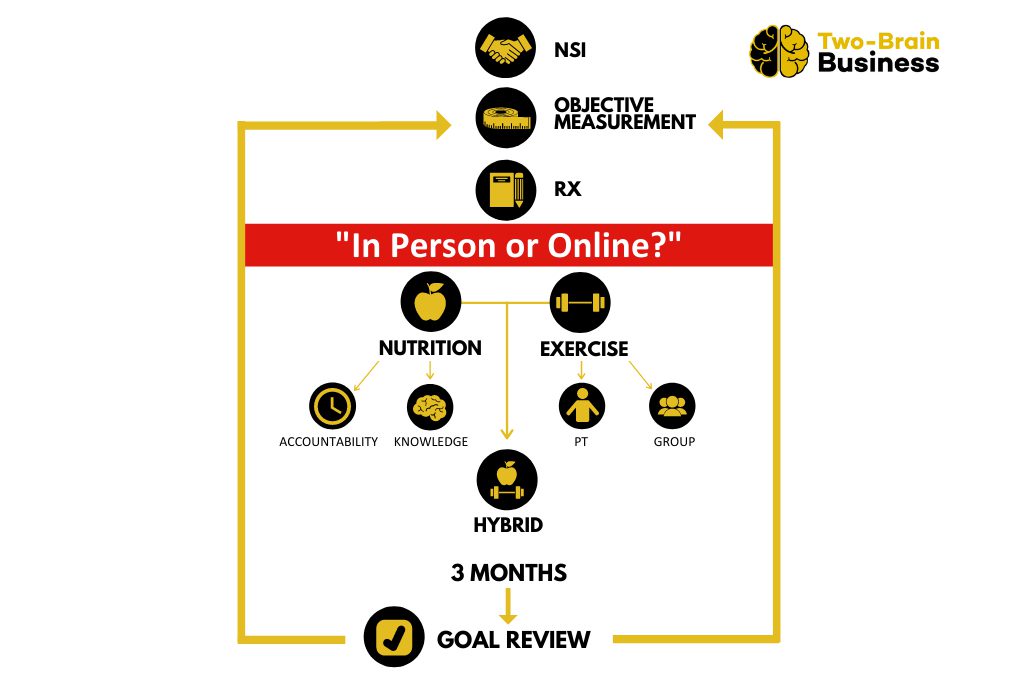If you’re a gym owner, you must learn how to sell more gym memberships. It’s the key to your success as an entrepreneur.
If you don’t work on sales, you can have an impressive operation with super coaches and still not seal the deal with enough prospective members to generate the revenue you need. Fortunately, we have ideas and techniques you can adopt to get more of your gym’s first-time visitors to become new members.
Below, we’ll share some great advice with you on how to sell a gym membership and answer some questions you might have about the processes used to sell more gym memberships.
Sell More Gym Memberships: Coaching or Access?
The most essential element of selling more gym memberships is focus. So before you develop or implement any new sales tactics, you must decide whether you are selling access to your gym or selling coaching.
Internet trading platforms and apps have given more people access to trading stocks and bonds without the guidance of a broker or advisor. Selling gym access is like similar: You allow clients to use your space and equipment for a monthly fee. Clients come and go as they please and do their own routines. In this model, you’re looking for hundreds and even thousands of clients at lower rates—perhaps $20-$50 per month. It’s a volume game, and client results aren’t your primary concern.
When you follow a coaching model, delivering results is critical, and you charge more for high-touch services that produce them. Value is more important than volume. Satisfied members who reach their goals will stick around longer and recommend your gym to their family, friends and business associates.
In this model, common starting points are 150 clients who each pay an average of $205 per month for nutrition, personal training and group fitness coaching, not just facility access. Some coaching gyms have average monthly rates over $300.
Target Markets and Strategic Advantages
As you can see, different clients are attracted to different kids of gyms, and your model will affect your marketing.
In short, you must know exactly what you are selling before you can sell more gym memberships. Once you know what you’re selling, you can define your target market and strategic advantages.
For example, an access-only gym with a daycare service might target busy parents who would jump at the chance to have their kids supervised while they do a workout. A coaching facility might target local professionals who want to lose weight and gain strength while working with a personal coach or in a small, trainer-led group.
The access facility wins if parents buy memberships and keep dropping their kids off to train. The coaching gym wins if high-value clients actually lose weight and get stronger. Both models can work, but the “perfect clients” for the first gym will be different from those the second gym will work to acquire.

How Affinity Marketing Can Improve Your Lead Flow
Leads are the key to selling new memberships, and successful gym owners closely monitor these three metrics:
- Set rate—the number of leads scheduled for a free consultation or No Sweat Intro.
- Show rate: the number of leads who show up for appointments.
- Close rate: the number of leads that show up and become members.
Advertising, promotional events and social media are suitable methods of generating leads. But Affinity Marketing leads are the cheapest and most convertible of all because they come to your gym through referrals from present gym members. These leads are often the gym member’s relatives, friends, acquaintances or business associates. Because the referring members have already hyped your gym, your good reputation and positive image precede you.
Your challenge is to get more of these very warm leads.
Get the “Affinity Marketing Guide” in our Free Tools package.
Getting More High-Affinity Leads With the Prescriptive Model
In coaching gym, your gym’s primary currency with clients is results. Your clients invest their money in you in exchange for help reaching their health and fitness goals. When they achieve success, you should have a pumped-up advocate who is eager to praise you to their friends, family and acquaintances. This can set you up to sell more gym memberships. But you must help your clients get results.
So the million-dollar question is, “What is the best way to help your clients get clear results?”
Our answer is to use the “Prescriptive Model” as a goal-setting, evaluating and coaching tool.
Can the prescriptive model work in an access-only gym? Yes—but it would be streamlined and tailored to recognize that prospective clients are looking for a low-touch service. In that scenario, a salesperson would still find out about the client and make a prescription, but it might just be “buy a monthly membership and sign up for an additional group step session each week.”
Below, we’ll present the full plan, and it can be adjusted if your access gym doesn’t offer goal reviews, which are essential in coaching gyms.

Inside the Prescriptive Model
The structure of the Prescription Model is simple because it starts with determining the clients’ goal—designated as “Point B.” Then you, the expert coach, establish a starting point—”Point A.” Within these points established, you can plot a path backward from Point B to Point A.
Use your expertise and experience to prescribe the best course of action clients can take to reach their goals.
For example, suppose you have a client whose goal is to reach 12 percent body fat from 24 percent body fat. In that case, your prescription might be an alternating schedule of personal coaching involving low-intensity interval training (LIIT) and high-intensity interval training (HIIT) five times a week, complemented by a habit-based nutrition plan designed to manage snacking, reduce added sugar and increase vegetable intake.
This is “selling” in the fitness industry: presenting the best solution to a problem or the shortest path to a goal.
Adjusting and Tracking Progress
After presenting your prescription, you’ll have objections to consider. Address issues by reminding the client about the importance of the goals, building value and adjusting the prescription if needed.
In our example, you could change the combination of routines, the number of days or the diet plan. Or you could offer the service in a group setting instead of one on one. If the prospective clients can move toward their goals with the adjusted plan, you’ll have a prescription that pleases and motivates them.
By establishing benchmarks along the way, you can motivate them by congratulating them at, say, four weeks completed, eight weeks completed, etc. Or perhaps when they drop 2, 4 or 6 lb. of fat. It is essential to track your clients’ progress toward their goals, make necessary adjustments and offer expert guidance. To keep the prescription on target, the best gyms hold an assessment session every three months to make any significant changes.
At its core, the Prescriptive Model is a goal-oriented, client-centered approach to helping clients achieve their goals. It offers two opportunities:
1. Sell to the client by prescribing the best solution to the problem.
2. With satisfied clients, acquire leads and referrals (Affinity Marketing).
How to Turn Leads Into Members
Whether you’re dealing with cold leads or referrals, your opportunity to sell starts as soon as you obtain contact information. Nurturing leads is an art in and of itself, so we’ll just say that new leads should be contacted as quickly as possible by phone, text and email. Your goal: Get the person to respond and book a consultation. If you don’t make contact, you must keep trying and eventually feed the contact info into your automated long-term nurturing sequences.
For more on that topic, check out “How to Get Gym Leads” from the experts at Gym Lead Machine.
Protip: If you succeed in getting a lead to book an appointment, be sure to send confirmations and reminders. Doing so will increase the chances that the person will show up.
Once a person arrives at your gym, each encounter is an opportunity to sign up a new member and sharpen your sales skills.

Getting to Know Your Prospect
Having top-notch facilities is a powerful asset. But it is not the primary catalyst in selling more memberships. Instead, prioritize your connection to your guest and gather as much information as you can. You must find out what they want to do and why. The “what” allows you to prescribe the correct services, and the “why” will help you overcome objections and make the sale. You should collect all the prospective member’s information on your intro form.
Remember, it’s not about you. It’s about them. Listen more than you talk, and ask lots of questions. For example, “Why do you want to lose 10 pounds?” or, “What would it mean to your family if you improved your fitness?” Try to discover the emotional connections to the goals.
This process will work in access gyms, too. Perhaps a client who just wanted a membership will purchase additional services, supplements or equipment if you dig a little and present solutions to problems.
When meeting with leads, dig to acquire this critical info:
- Exercise experience: favorite exercise forms and training styles, dislikes, previous gym memberships, previous successes, reasons for quitting, etc.
- Goals and measures of success: essential for you to make a prescription and track progress.
- Motivation: factors and people involved, commitment levels, decision-making priorities.
- Barriers to success: the things that can cause the person to leave without joining or quit the gym after joining.
In some cases, it’s wise to include a free workout or tour in your consultation. But don’t let that become the focus, and don’t let the person leave without a sales conversation. You must find out about goals and offer a prescription! We recommend you write that prescription down and present the prices to the client with a sales binder or iPad.
If the client signs up, that’s a win. Get the person into your on-ramp/intro program ASAP.
If the client raises objections, you’ll have to address them. Remember: The client came to you to solve a problem. You’re not being pushy. You’re helping the client by offering solutions.
Here’s a video that will help you solve problems for clients:
We’ll cover sales training and more objections below.
Converting More Leads by Becoming a Better Salesperson
There are some basic things you can do to improve your chances of making the sale.
First, body language and appearance are essential in conveying that you are confident and trustworthy. Dress like a “fitness pro,” and wear branded apparel. Smile and be very friendly. Work to set people at ease—many will be nervous. In addition, giving your visitors your full attention is imperative, meaning you should mute your cell phone and your eyes should be on your prospective member. Meetings should take place in clean, organized sales office.
Here are some points of focus:
1. Along with discovering their goals, try to find the emotion fueling your prospect’s drive to reach them. Maybe it’s the fear of having a heart attack or a strong desire to make lifestyle changes due to a significant upcoming life event, like a wedding. If a person isn’t ready to commit, reminding them of their goals and why they are important can save the sale.
2. Another effective technique is asking questions that generate “yes answers” for most of the meeting until you ask for the sale. For example, you could ask questions like:
- Do you like that you won’t have to wait for equipment to be free here?
- Given your busy schedule, do you like our new expanded hours?
- So you’re saying that weight loss is most important to you?
3. You can also strengthen your pitch with an “option close.” Here are two examples:
- “So would you prefer to train one on one with me or in a group?”
- “I can see you’re into group training. Of our platinum and gold packages, which option works best for you?”
Here are two more videos with sale tips to help gym owners sell more memberships:
How to Sell More Memberships by Dealing With Roadblocks
As you hone your sales technique, the entire process will go more smoothly, and you will start to sell more gym memberships.
A servant/leader mindset will help you stay in the mode of assisting people to reach their goals and prosper. Most people instinctually know when someone is coming from a place of care instead of a place of self-benefit, and the book “Help First” will help you take the right approach.
Due to technological advances, the average person receives or views 4,000-10,000 sales messages a day. As a result, most people automatically detect a sales pitch and immediately put up a rejection screen. Keeping this in mind will help you show genuine care for a person’s needs, and it will help you sell more gym memberships.
However, even on your most smokin’ days, you might encounter roadblocks with a potential client that can confound you if you’re not ready to overcome them. So, let’s examine these potential membership sales problems so you can learn how to deal with them. Remember: If you don’t overcome the roadblocks, the prospective client will leave and miss out on a chance to dramatically improve health and fitness.

Sell More Gym Memberships with Role-Playing Practice
If you suffer from fear of rejection or feel insecure in your sales abilities, a jittery intro meeting can hamper your membership sales effort. However, Michael Jordan once said, “Being nervous isn’t bad. It just means something important is happening.”
The best way to harness your nervous energy is to develop a sales rhythm through repetition and practice. As mentioned earlier, the only way to ingrain a habit is to repeat it thousands of times. Therefore, role-playing intro sessions over and over will pay dividends.
Your actions and reactions are critically important during the intro, so it’s good to rehearse your presentation and the questions you ask prospective gym members. The more “reps” you get, the better you’ll perform when a real prospective client is in your office.
All you need is a friend or associate to play the role of the buyer. Before the drill starts, your partner must assume the role of the potential member, portraying someone who is in your target market.
During the role-playing sessions, you should focus on your weakest areas. For example, if you are a weak closer, you should concentrate on improving in that area. It also helps if your “buyer” is prepared to offer a number of common objections, either in the same consultation or by taking on a new persona for another intro session.
Role playing is an excellent low-pressure method to help you overcome your lack of confidence in conducting and closing membership sales activities on the way to increased revenue. The more your practice, the more prepared you’ll be. And when you’re prepared, you’ll be able to smoothly work with the potential client to find solutions.
Overcoming Budgetary Objections
The most common objections often relate to price or budget:
- “It’s too expensive.”
- “I can’t afford it.”
- “’I can’t pay for it right now.”
Do these responses seem familiar? You might have used them a few times yourself.
There are some practical ways to address these price- and budget-related statements. The first thing: Do not overreact to an objection. Stay calm. If you’ve practiced dealing with price objections during role playing—highly recommended—it will be easy to keep your emotions in check.
Practice will supply you with a tactful script for the price objection, which will improve the quality of your response and drive up your close rate. You should also have a plan for other common objections, such as “I have to ask my spouse,” “I’ll come back later” and “I need to think about it.”
When prospects say the price is too high, they are really comparing your gym to another. Find out what gym they are comparing yours to. When you find out, you can point out the advantages your gym has over the other without criticizing or tearing it down. The goal is to build value around your business, and in many cases you’ll have to educate the client.
For example, salespeople at coaching gyms often get a price objection because leads are used to hearing pitches for $30-a-month rates at access-only gyms. In this scenario, the salesperson must explain how the two types of gyms differ.
Regardless of the objection, you can use this process to frame your response:
- Acknowledge with empathy: ”Thank you for letting me know how you feel.”
- Ask a question that leads to the sale: “What other gyms are you comparing us to?”
- Engage in a strategy session with them to produce a solution: “How important is personalized coaching to you?”
To make this process work, you must know your competition, their price structure and everything they have to offer. You must also know your own strategic advantages. Then you can combine all that knowledge with the personal information you gained earlier in the meeting to point out how your gym can help them reach their goals.
Here’s another video resource for you:
Sell More Gym Memberships: FAQs
Q: Is there such a thing as an “unqualified lead?”
A: Just because a lead walks out of your gym without signing up does not mean that person is an unqualified lead. The fitness industry has done a terrific job of using mass and electronic media to make consumers fully aware of what gyms offer. So when most leads enter your gym, they know what they are looking for in a fitness facility. So why did they leave without buying?
We are not mind readers, and we can never truly know why people make their decisions, even when they provide a reason. It is best to look at each unsigned lead as an opportunity to learn from the questions they asked, their demeanor and other clues they supplied. That review will help you improve your skills so you can close your next lead.
Q: Could it be that I’m just a lousy salesperson?
A: You might be surprised, but this thought enters the minds of many people in business. Usually, this thought process stems from FEAR—false evidence that appears real. Having a string of lost sales doesn’t mean you’re a lousy salesperson. Instead, it probably means you haven’t found your rhythm yet.
When you practice your sales craft in role playing, it’s good to have a third person critique your delivery to pinpoint the areas you need to improve. But most importantly, ditch the salesperson label and envision yourself as an empathetic servant leader prepared to assist your prospective members in reaching their goals. Think of it as “helping,” not selling.
Q: When talking to a potential client, what’s the most important thing to focus on?
To sell more gym memberships, you should focus on what your leads want and why they need it. This focus will help you close sales and create a long-term bond with your client. That can produce better results for them and high retention rates for you.
Q: Do I have to assemble the most knowledgeable coaches to succeed?
Having a team of highly credentialed and knowledgeable coaches is terrific. However, it doesn’t necessarily mean you’ll sell more memberships. According to Two-Brain founder Chris Cooper, relying solely on technical prowess to make your gym a success is a mistake because “credentials don’t sell. Conversations do.”
Regardless of your expertise, you and your staff must connect with prospective clients and offer the things they care about: solutions to problems and progress toward goals. Your knowledge, technical ability and credentials are valuable only in solving clients’ problems, not in closing sales. Getting your clients results is always the bottom line in selling more gym memberships and retaining members. And remember, retention requires “re-selling,” so work hard to prove your value every day.
Q: Is it enough to be a great coach? If I “build it,” will they come?
No. This common advice is false. You must learn to market and sell to run a successful business. The good news: You can learn.

How to Sell More Gym Memberships: Key Takeaways
Selling more gym memberships is not a complicated task when you approach it with the right frame of mind and preparation.
As gym owners, you aren’t selling lemons off the used-car lot or peddling useless gimmicks. So you don’t have to feel slimy. You’re helping people improve their health and fitness, and you deserve to be compensated for that valuable service. Focus on helping and you’ll feel much better at sales.
Then invest time in practicing. There’s no substitute for reps. Get as many as you can so you’re ready when it gets real in the sales office.
Remember: Your gym won’t fill itself. You have to sell. And we can teach you how to do it.
To learn more about mentorship, click here.
About the Author: John Burson successful ran a personal training business for over 20 years, and he has written volumes of published articles on business entrepreneurship, finance, and the fitness industry.

